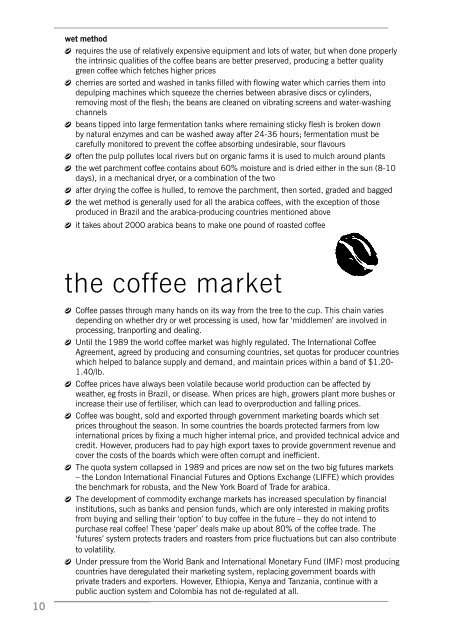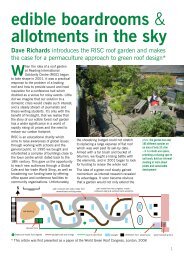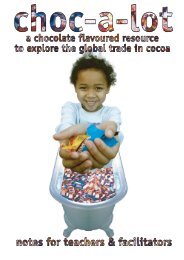Cost of coffee.indd - RISC
Cost of coffee.indd - RISC
Cost of coffee.indd - RISC
You also want an ePaper? Increase the reach of your titles
YUMPU automatically turns print PDFs into web optimized ePapers that Google loves.
wet method<br />
D requires the use <strong>of</strong> relatively expensive equipment and lots <strong>of</strong> water, but when done properly<br />
the intrinsic qualities <strong>of</strong> the c<strong>of</strong>fee beans are better preserved, producing a better quality<br />
green c<strong>of</strong>fee which fetches higher prices<br />
D cherries are sorted and washed in tanks filled with flowing water which carries them into<br />
depulping machines which squeeze the cherries between abrasive discs or cylinders,<br />
removing most <strong>of</strong> the flesh; the beans are cleaned on vibrating screens and water-washing<br />
channels<br />
D beans tipped into large fermentation tanks where remaining sticky flesh is broken down<br />
by natural enzymes and can be washed away after 24-36 hours; fermentation must be<br />
carefully monitored to prevent the c<strong>of</strong>fee absorbing undesirable, sour flavours<br />
D <strong>of</strong>ten the pulp pollutes local rivers but on organic farms it is used to mulch around plants<br />
D the wet parchment c<strong>of</strong>fee contains about 60% moisture and is dried either in the sun (8-10<br />
days), in a mechanical dryer, or a combination <strong>of</strong> the two<br />
D after drying the c<strong>of</strong>fee is hulled, to remove the parchment, then sorted, graded and bagged<br />
D the wet method is generally used for all the arabica c<strong>of</strong>fees, with the exception <strong>of</strong> those<br />
produced in Brazil and the arabica-producing countries mentioned above<br />
D it takes about 2000 arabica beans to make one pound <strong>of</strong> roasted c<strong>of</strong>fee<br />
the c<strong>of</strong>fee market<br />
10<br />
D C<strong>of</strong>fee passes through many hands on its way from the tree to the cup. This chain varies<br />
depending on whether dry or wet processing is used, how far ‘middlemen’ are involved in<br />
processing, tranporting and dealing.<br />
D Until the 1989 the world c<strong>of</strong>fee market was highly regulated. The International C<strong>of</strong>fee<br />
Agreement, agreed by producing and consuming countries, set quotas for producer countries<br />
which helped to balance supply and demand, and maintain prices within a band <strong>of</strong> $1.20-<br />
1.40/lb.<br />
D C<strong>of</strong>fee prices have always been volatile because world production can be affected by<br />
weather, eg frosts in Brazil, or disease. When prices are high, growers plant more bushes or<br />
increase their use <strong>of</strong> fertiliser, which can lead to overproduction and falling prices.<br />
D C<strong>of</strong>fee was bought, sold and exported through government marketing boards which set<br />
prices throughout the season. In some countries the boards protected farmers from low<br />
international prices by fixing a much higher internal price, and provided technical advice and<br />
credit. However, producers had to pay high export taxes to provide government revenue and<br />
cover the costs <strong>of</strong> the boards which were <strong>of</strong>ten corrupt and inefficient.<br />
D The quota system collapsed in 1989 and prices are now set on the two big futures markets<br />
– the London International Financial Futures and Options Exchange (LIFFE) which provides<br />
the benchmark for robusta, and the New York Board <strong>of</strong> Trade for arabica.<br />
D The development <strong>of</strong> commodity exchange markets has increased speculation by financial<br />
institutions, such as banks and pension funds, which are only interested in making pr<strong>of</strong>its<br />
from buying and selling their ‘option’ to buy c<strong>of</strong>fee in the future – they do not intend to<br />
purchase real c<strong>of</strong>fee! These ‘paper’ deals make up about 80% <strong>of</strong> the c<strong>of</strong>fee trade. The<br />
‘futures’ system protects traders and roasters from price fluctuations but can also contribute<br />
to volatility.<br />
D Under pressure from the World Bank and International Monetary Fund (IMF) most producing<br />
countries have deregulated their marketing system, replacing government boards with<br />
private traders and exporters. However, Ethiopia, Kenya and Tanzania, continue with a<br />
public auction system and Colombia has not de-regulated at all.




